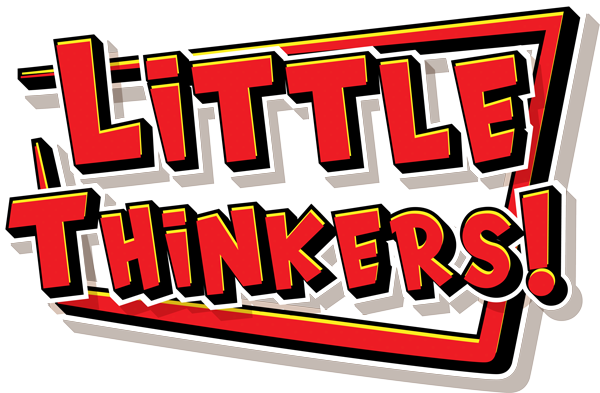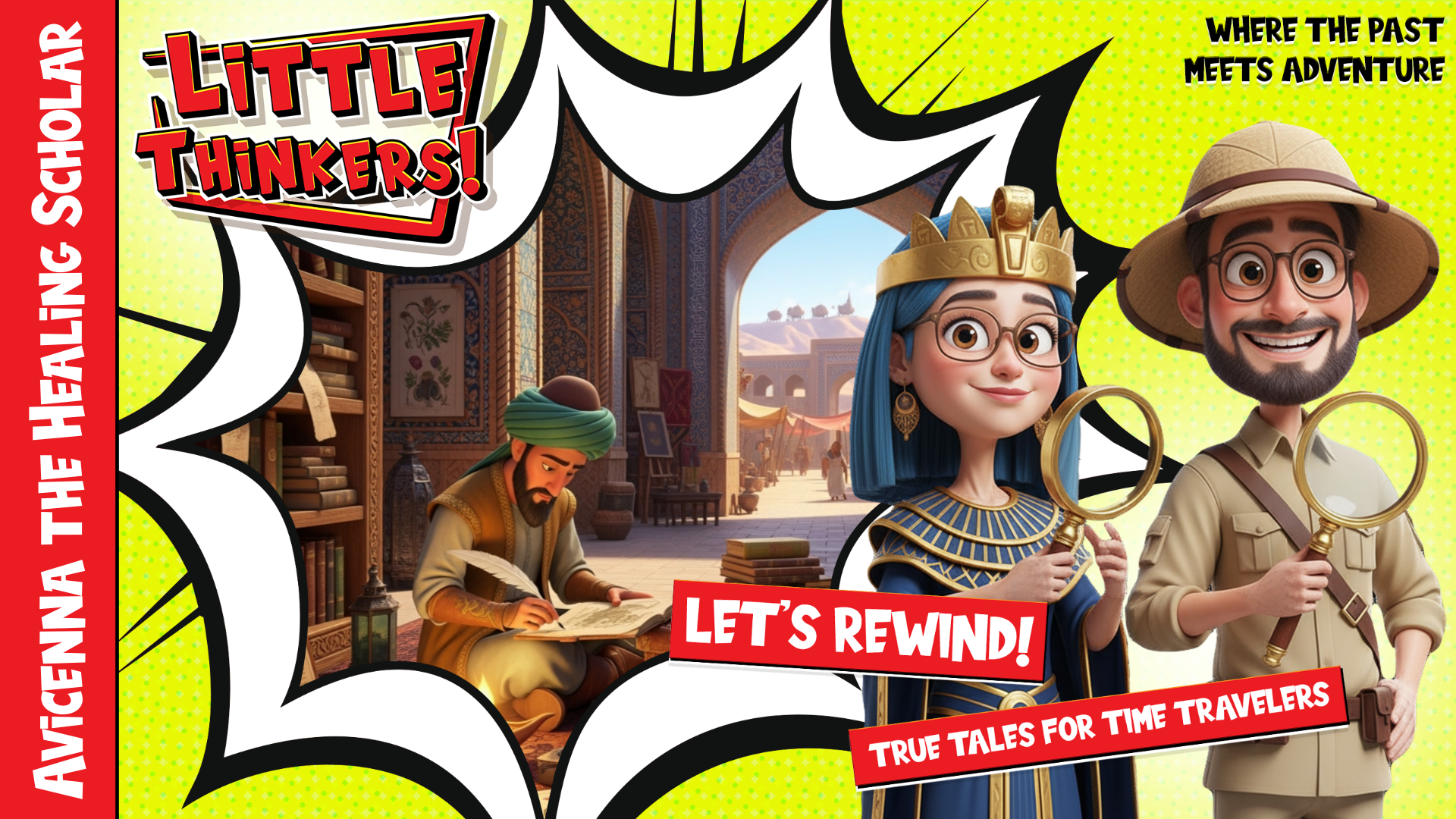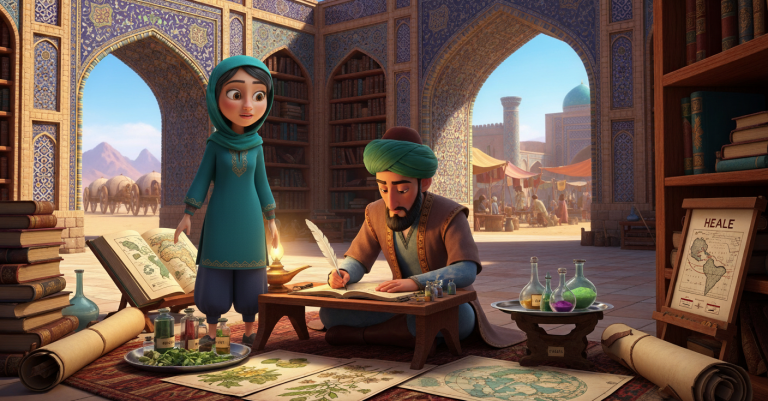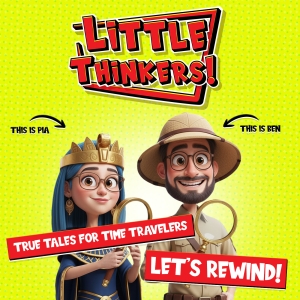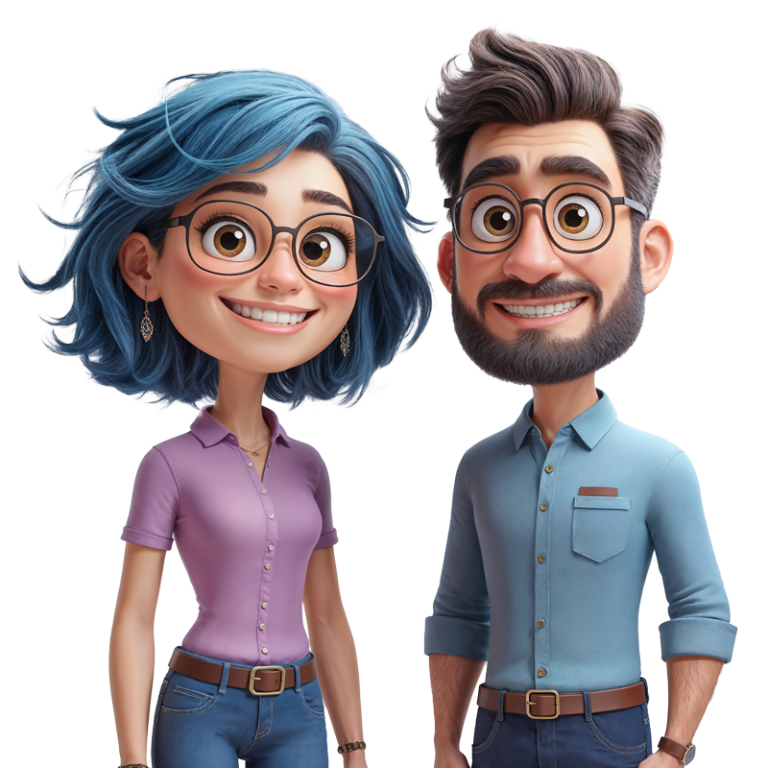The Amazing Boy Doctor Who Changed Medicine Forever
Imagine This Magical Scene
Picture a small room lit by a flickering oil lamp. A ten-year-old boy sits cross-legged on a soft carpet, reading by the golden light. Outside, the bustling city of Bukhara hums with activity – camels bells jingling, merchants calling out their wares, and the clip-clop of horses on stone streets. But inside this quiet room, something incredible is happening. This boy has just memorized the entire Quran! His name is Ibn Sina, but the world would come to know him as Avicenna – one of the greatest doctors and thinkers who ever lived.
What makes this story even more amazing? This brilliant boy would grow up to write a medical book so good that doctors used it for over 600 years! That’s like using the same textbook from before America was discovered all the way to today. Are you ready to discover how a curious child from Central Asia became a medical superhero?
The Boy Wonder of Ancient Bukhara
In the year 980, in what is now Uzbekistan, little Ibn Sina was already showing signs of being extraordinary. While other kids his age were playing with wooden toys, he was asking deep questions about how the world worked. His father was an important government official who often hosted smart visitors – mathematicians, astronomers, and philosophers who would gather in their home to discuss big ideas.
Young Ibn Sina would sit quietly in the corner, listening to these grown-ups talk about numbers, stars, and the mysteries of life. But he wasn’t just listening – he was absorbing everything like a sponge! When the visitors left, he would ask his father thoughtful questions that amazed the adults.
Fun Fact!
By age 10, Ibn Sina had not only memorized the entire Quran (that’s about as long as the whole Harry Potter series!), but he could also recite it backwards and explain what every verse meant. Teachers from across the city came just to test this incredible young mind!
The Day Everything Changed
One ordinary morning, something happened that would shape Ibn Sina’s entire future. A neighbor fell seriously ill, and the local healer was called to help. Young Ibn Sina watched, fascinated, as the doctor checked the sick man’s pulse, looked at his eyes, and mixed herbs into healing potions.
“How do you know what’s wrong with him?” the curious boy asked. The healer smiled and explained how different signs in the body tell a story about what’s happening inside. That moment was like lightning striking – Ibn Sina knew he had found his calling!
He immediately began borrowing every medical book he could find. These weren’t easy books written for children – they were serious texts by ancient Greek doctors like Hippocrates and Galen, carefully translated into Arabic and Persian. While most kids his age struggled to read simple stories, Ibn Sina was devouring complex medical theories!
Did You Know?
The Islamic world in Ibn Sina’s time was like the internet of knowledge! Scholars traveled thousands of miles to share ideas, and books were translated into many languages. A medical discovery in Baghdad could reach Spain in just months – pretty amazing for a time without phones or computers!
The Teenage Doctor
By age 16, something incredible happened – Ibn Sina was already practicing medicine! But he wasn’t just copying what older doctors did. He was thinking differently. He kept detailed notes about every patient, writing down what worked and what didn’t. He noticed patterns that other doctors missed.
For example, he observed that some diseases seemed to spread from person to person, so he advised keeping sick people separate from healthy ones. This was revolutionary thinking – it would be hundreds of years before European doctors understood how germs spread!
Then came his big break. The ruler of Bukhara became very ill, and none of the royal doctors could help him. In desperation, they called for the young physician everyone was talking about. Ibn Sina examined the ruler carefully, prescribed simple treatments, and amazingly, the ruler recovered!
The Greatest Reward Ever
As a reward for saving his life, the grateful ruler gave Ibn Sina access to the royal library – one of the greatest collections of books in the world! Imagine having every book ever written at your fingertips. Ibn Sina spent days and nights reading works by scholars from India, Greece, Persia, and the Arab world, gathering knowledge like pieces of a giant puzzle.
Life Gets Complicated
But life isn’t always smooth, even for geniuses. Political troubles erupted in Bukhara, and Ibn Sina had to flee his beloved city. He packed his most precious possessions – his medical notes and books – into leather bundles and joined a caravan heading west.
Picture this: camels trudging across endless desert sands, their bells jingling in rhythm with their steps. At night, when the caravan stopped to rest around flickering campfires, Ibn Sina would pull out his notebooks and continue writing by firelight. He was determined that no matter where life took him, he would keep learning and helping people.
During his travels, he served various rulers as both a doctor and an advisor. Sometimes this brought him honor and comfortable living. Other times, it brought danger – he was even thrown in prison once for political reasons! But even in a dark jail cell, Ibn Sina kept thinking and writing, scratching notes on any scrap of paper he could find.
Amazing Journey Facts
- Ibn Sina lived in over 10 different cities during his lifetime
- He wrote many of his books while traveling on horseback
- His portable medicine chest contained over 50 different remedies
- He could diagnose illnesses just by feeling a patient’s pulse
The Medical Masterpiece
Finally settling in Isfahan (in present-day Iran), Ibn Sina began his greatest work – The Canon of Medicine. This wasn’t just any book – it was like creating the world’s first medical encyclopedia, textbook, and how-to guide all rolled into one!
The Canon was organized like a perfectly planned city. The first section covered general principles of health and disease. The second section described over 760 different medicines and how to prepare them safely. The third, fourth, and fifth sections covered diseases of specific body parts, general diseases like fevers, and complex medical preparations.
But what made Ibn Sina’s book truly revolutionary was his scientific approach. He insisted that all medical treatments be tested carefully before being used. He wrote: “Try one medicine at a time, note the exact dose, and compare results across different patients.” This was the birth of what we now call clinical trials!
Mind-Blowing Medicine Facts
Ibn Sina’s book described how to perform eye surgery, set broken bones, and even outlined the stages of pregnancy week by week! He explained that some mental illnesses were actually caused by physical problems in the brain – an idea that wouldn’t be accepted in Europe for another 500 years!
The Book That Traveled the World
Soon, copies of the Canon were traveling along the same trade routes that carried silk and spices. Scribes carefully copied the text by hand, wrapping the precious pages in leather and wax for protection. Caravans carried these medical treasures across mountains and deserts to distant lands.
In the 1100s, something amazing happened in the Spanish city of Toledo. Scholars there translated the Canon from Arabic into Latin, making it available to European doctors for the first time. Suddenly, medical schools from Paris to London were teaching from Ibn Sina’s book!
For over 600 years – longer than the United States has existed – the Canon of Medicine remained the standard medical textbook in European universities. Students in medieval medical schools would memorize entire sections, just as Ibn Sina had memorized the Quran as a child.
Fun Medieval Facts
- European doctors called him “Avicenna” because Latin speakers found “Ibn Sina” hard to pronounce
- His book was among the first medical texts printed on Gutenberg’s printing press
- Medieval medical students had to swear an oath to follow Avicenna’s ethical guidelines
- Some hospitals were named “Avicenna Houses” in his honor
More Than Just Medicine
But wait – there’s more! Ibn Sina wasn’t only a doctor. He was also a brilliant philosopher, mathematician, and scientist. He wrote a massive work called “The Book of Healing” – but it wasn’t about medicine. Instead, it was about healing the mind through knowledge and understanding.
In this book, he explored deep questions: How do we know what we know? What makes us who we are? He even came up with a thought experiment that philosophers still discuss today: If you couldn’t see, hear, touch, or feel anything, would you still know that you exist? (The answer, he believed, was yes!)
Ibn Sina also made discoveries in astronomy, chemistry, and physics. He studied the speed of light, the formation of mountains, and the causes of earthquakes. He was like a one-man university, pushing forward human knowledge in every direction!
Renaissance Before the Renaissance
Ibn Sina lived during what historians call the “Islamic Golden Age” – a time when Muslim scholars were making incredible discoveries in every field. While Europe was going through the “Dark Ages,” cities like Baghdad, Cairo, and Cordoba were blazing with learning and innovation!
The Wisdom of a Lifetime
As Ibn Sina grew older, he faced the same human frailty he had spent his life trying to heal in others. But he approached his own illness with the same scientific curiosity he brought to everything else. He tried his own treatments, observed their effects, and continued working until the very end.
When he died in Hamadan (in present-day Iran) in 1037 at age 58, he left behind more than 100 books on subjects ranging from medicine to music theory. But more importantly, he left behind a new way of thinking about health and healing that emphasized careful observation, scientific testing, and compassionate care.
His students and followers made sure his ideas lived on. They copied his books, taught his methods, and carried his torch of learning to new generations. The ripple effects of his work spread across continents and centuries.
Legacy That Lives On
Today, you can find statues of Avicenna in cities from Tehran to Paris. Medical schools around the world still teach some of his principles. The World Health Organization has honored him as a pioneer of medicine. And in 2013, UNESCO declared his 1000th death anniversary as a year of international celebration!
What We Can Learn from Avicenna Today
So what can we learn from this amazing man who started as a curious boy in ancient Bukhara? First, that curiosity is one of the most powerful forces in the world. Ibn Sina never stopped asking questions, even when the answers led him into dangerous or difficult territory.
Second, he showed us that knowledge belongs to everyone. He didn’t hoard his discoveries or keep them secret. Instead, he wrote them down clearly so that others could learn, improve, and build upon his work. His books traveled across cultural and religious boundaries because good ideas don’t recognize borders.
Third, he demonstrated that helping others and pursuing knowledge can go hand in hand. He never forgot that behind every medical case was a real person who needed care and compassion. Science without kindness, he knew, was incomplete.
Finally, Ibn Sina proved that one person, armed with curiosity and determination, can change the world. He started with nothing but questions and ended up improving the lives of millions of people across many centuries.
Modern Medical Heroes
Today’s medical researchers still follow many of Avicenna’s principles! When scientists test new medicines, they use methods very similar to what he described 1000 years ago. Doctors still take careful notes, observe patterns, and put patient care first – just like their ancient predecessor from Bukhara.
History Is All Around Us
The next time you visit a doctor or take medicine when you’re sick, remember Ibn Sina. The careful way your doctor examines you, asks questions about your symptoms, and explains what might be wrong – all of this traces back to the methods developed by a curious boy in Central Asia over 1000 years ago.
When you see a medical textbook, think about how it descended from the Canon of Medicine. When you hear about new medical research being tested carefully before being used, remember who first insisted on this scientific approach.
Ibn Sina’s story reminds us that history isn’t just about kings and battles – it’s also about thinkers and healers, questioners and helpers. It’s about young people like you who look at the world with curious eyes and wonder how they might make it better.
Who knows? Maybe you’ll be the next great medical pioneer, carrying on the tradition that started with a boy reading by lamplight in ancient Bukhara. The world is still full of mysteries waiting to be solved, and every great discovery starts with someone brave enough to ask: “How does this work, and how can we make it better?”
Your Turn to Explore
Next time you’re curious about something, follow Avicenna’s example: observe carefully, ask good questions, keep notes, and never stop learning. Who knows what amazing discoveries are waiting for your curious mind to uncover!
